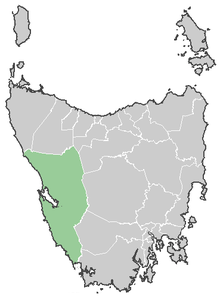West Coast Tasmania
Regions

The West coast has often thought about as starting at Mount King William on the Lyell Highway, or at Mount Black on the Murchison Highway, once you have ventured past those points of the traditional road access, you are in the west coast region.
The old mining towns, and the recent hydro town of Tullah are the main focus points of the internal regions of the west coast.
The West Coast is separate from the south west, which does have a link from the east as far as Strathgordon. That is far as the road goes there.
Other destinations
Understand
West Coast Tasmania is often associated with the South West, as the term 'Tasmanian Wilderness' is used in promoting areas in the west coast, as much as where the term was first coined - for the South West, when it became recognised as a World Heritage region.
West Coast Tasmania is a very attractive tourist region as it has historic mine sites, historic mining towns, and railways (rebuilt), as well as places to stay. It wasn't so easy to get into as recently as the 1950s when it was easier to travel in by ship or railway, than by the roads that now exist. The isolated nature of the region, being cut off from the southern and northern parts of Tasmania by mountains and wild country, has perpetuated a range of myths about the tough west coasters (The Queenstown Football Oval is a prime example - it is not grassed, but is gravel surfaced) and the wild former convict locations like Sarah Island and Macquarie Harbour. The mouth or entry of Macquarie Harbour is aptly named 'Hells Gates', and the west coast coastline is liberally supplied with wrecks, record waves, and other elements of what long uninhabited coasts have.
The main towns of Queenstown, its former main port - Strahan, Zeehan, and Rosebery are the main historic towns that have colourful histories, as well as modern tourist facilities. They are connected by twisty, dangerous roads (various reasons for different roads) and are not close to each other, so that the communities in the past have had separate communities with rivalries and differences, either sporting or otherwise. Also the region has ghost towns, and vanished towns, lost to the fates of former mining towns or companies no longer operating.
Strahan, formerly just a link in the railway system of fifty years ago, is now a hub - places to stay, a variety of places to drink and eat in the tourist season, and a place to take trips on a rebuilt railway, and boat trips across Macquarie Harbour, and more than one road out to other places to visit.
Zeehan, almost but not a ghost town, is an excellent example of a one main street town that hasn't lost all of its old civic buildings to ruin or fire. The museum and remnants of the past are well presented and well worth visiting.
The HEC or Hydro, as it was known, the dam builder that was planning the Franklin Dam, is much downsized these days, but its legacy is a fine set of roads into parts of the west coast that were formerly hard to get into. The short cut road off the Zeehan Highway that goes along the west side of the West Coast Range up to Tullah, thereby bypassing Zeehan and Renison, is a road with very picturesque scenery and mountains to view. The highway south of Queenstown, up and around the northern side of Mount Jukes to near the former ghost town of Crotty, offers great views over Lake Burbery and towards Frenchmans Cap. There are also good Hydro roads west of Tullah and Rosebery that go towards the mouth of Pieman River on the coast.
Get in
The only way to reach the West Coast is by road.
- From the north west, travel south on the Ridgley Highway from Burnie, the Murchison Highway from Somerset, or on one of the smaller roads from Smithton.
- From the north, you can cut through the Central Highlands, and join the Lyell Highway at some point and enter from the east.
- From the south, the Lyell Highway begins on the south side of the Bridgewater Bridge and runs all the way to Queenstown and ending in Strahan.
If you are fortunate enough to travel by sea-worthy boat (very rare), you can travel into the west coast and find Strahan, or Regatta Point in Macquarie Harbour as a good port of call. You would have travelled around from Hobart, or somewhere on the northern coast, and survived the west coast the way the original explorers would have encountered.
The tonnage of the boat, and its draught have to be taken into account the conditions of Macquarie heads, otherwise known as Hells Gates, and any local knowledge would be of benefit when encountering the entrance into the harbour. Almost all the rest of the west coast is unsuitable for dropping anchor.
Get around
There are public bus services into the west coast, but most people travelling in use cars as the main way to get around.
The mountainous country is not enough to deter the enthusiastic or extreme cyclist, but the roads are narrow and not cycle friendly.
See
- Tullah
- Rosebery
- Williamsford/Mount Read
- Zeehan
- Trial Harbour
- Strahan
- Macquarie Heads
- Regatta Point
- Queenstown
- Gormanston
- Lake Burbery
Do
Eat
Drink
Each west coast town has its own pub or local hotel.
Stay safe
When travelling into the west coast, the roads are narrow and in the right seasons frequently slippery from rain, ice and fallen scree from hillsides.
Go next
- Travelling along the Lyell Highway east to -
- Southeast Tasmania
- Travelling along Lyell Highway and cutting across Central Highlands to -
- Northeast Tasmania
- East Coast
- Travelling along the Murchison Highway north to -
- North West Coast